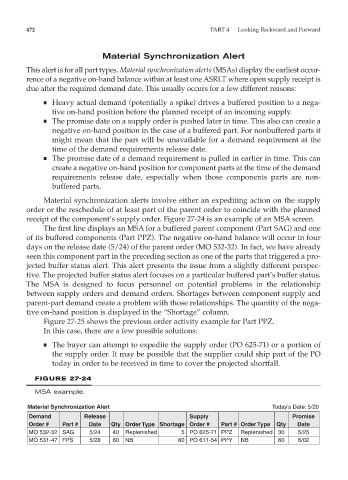Page 495 - Orlicky's Material Requirements Planning
P. 495
472 PART 4 Looking Backward and Forward
Material Synchronization Alert
This alert is for all part types. Material synchronization alerts (MSAs) display the earliest occur-
rence of a negative on-hand balance within at least one ASRLT where open supply receipt is
due after the required demand date. This usually occurs for a few different reasons:
■ Heavy actual demand (potentially a spike) drives a buffered position to a nega-
tive on-hand position before the planned receipt of an incoming supply.
■ The promise date on a supply order is pushed later in time. This also can create a
negative on-hand position in the case of a buffered part. For nonbuffered parts it
might mean that the part will be unavailable for a demand requirement at the
time of the demand requirements release date.
■ The promise date of a demand requirement is pulled in earlier in time. This can
create a negative on-hand position for component parts at the time of the demand
requirements release date, especially when those components parts are non-
buffered parts.
Material synchronization alerts involve either an expediting action on the supply
order or the reschedule of at least part of the parent order to coincide with the planned
receipt of the component’s supply order. Figure 27-24 is an example of an MSA screen.
The first line displays an MSA for a buffered parent component (Part SAG) and one
of its buffered components (Part PPZ). The negative on-hand balance will occur in four
days on the release date (5/24) of the parent order (MO 532-32). In fact, we have already
seen this component part in the preceding section as one of the parts that triggered a pro-
jected buffer status alert. This alert presents the issue from a slightly different perspec-
tive. The projected buffer status alert focuses on a particular buffered part’s buffer status.
The MSA is designed to focus personnel on potential problems in the relationship
between supply orders and demand orders. Shortages between component supply and
parent-part demand create a problem with those relationships. The quantity of the nega-
tive on-hand position is displayed in the “Shortage” column.
Figure 27-25 shows the previous order activity example for Part PPZ.
In this case, there are a few possible solutions:
■ The buyer can attempt to expedite the supply order (PO 625-71) or a portion of
the supply order. It may be possible that the supplier could ship part of the PO
today in order to be received in time to cover the projected shortfall.
FIGURE 27-24
MSA example.
Material Synchronization Alert Today’s Date: 5/20
Demand Release Supply Promise
Order # Part # Date Qty Order Type Shortage Order # Part # Order Type Qty Date
MO 532-32 SAG 5/24 40 Replenished 5 PO 625-71 PPZ Replenished 30 5/25
MO 531-47 FPS 5/28 60 NB 60 PO 611-54 PPY NB 60 6/02

